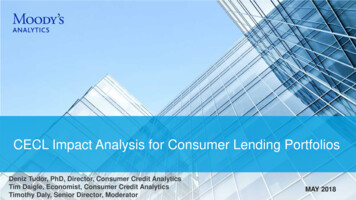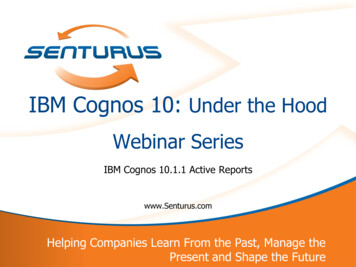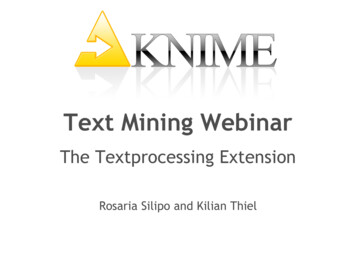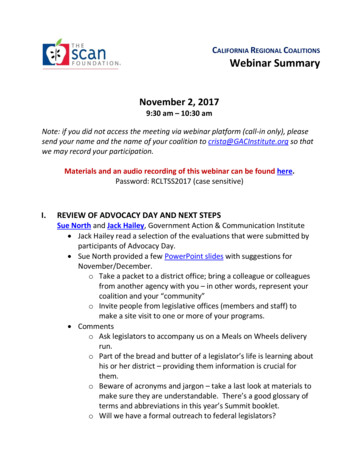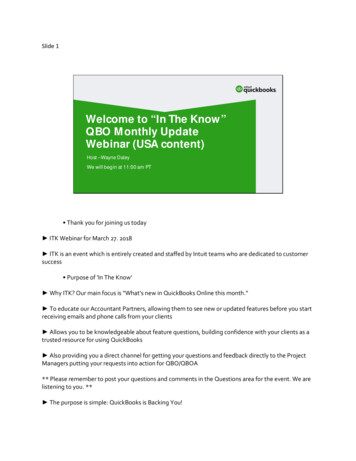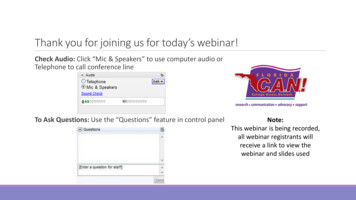
Transcription
CECL Webinar Series:The Roadmap to SuccessGlenn Levine, Associate DirectorDavid Fieldhouse, DirectorSeptember 6, 2017
Moody’s Analytics CECL Webinar Series:The Roadmap to SuccessTODAYLifetime Expected Credit Loss ModelingUPCOMING EVENTSTue, Sep 19Economic Scenarios for CECL: What’s Reasonable and Supportable?Thur, Oct 5Empowering Users, Satisfying AuditorsLifetime Expected Credit Loss Modeling, September 6, 20172
Moody’s Analytics CECL Solution SuiteToday’s Focus is on ModelsLifetime Expected Credit Loss Modeling, September 6, 20173
Today’s SpeakersGlenn LevineAssociate Director, Credit Risk Analytics GroupGlenn is a quantitative researcher in the Credit Risk Analytics Group. He provides supportfor the CreditEdge product suite and is the lead researcher for Stressed EDF, a modelwhich allows corporate credit risk to be conditioned on different macroeconomicscenarios. Prior to his current role, he was a Senior Economist in MA’s Economics andConsumer Credit division, based in Sydney, Australia. He holds an MSc from the LondonSchool of Economics.David FieldhouseDirector, Consumer Credit AnalyticsDr. David Fieldhouse is a Director in the Content Economics and Structured AnalyticsGroup. His responsibilities include developing and validating models of consumer loanperformance for financial institutions. He also provides regular analysis and commentaryon consumer credit markets. David has a PhD from the University of Western Ontario.ModeratorAnna KraynSenior Director and Team Lead, Capital Stress Testing Business DevelopmentAnna is a senior director who manages the regulatory and accounting solutions team inthe Americas. The team is responsible for solutions structuring, leveraging Moody’sAnalytics products and services focusing on impairment, stress testing, and capitalplanning solutions. Her primary focus is on financial institutions.
CECL Implementation ConcernsModel-related issues consistently rank highWhat is the most significant challenge you anticipate inCECL implementation?February 2017August 20172%10%10%32%11%35%37%18%18%27%Data availabilityECL quantificationScenario designQualitative overlay methodologyPerformance (i.e. speed of execution)Data and processes governanceData availabilityScenario selection, design, and supportExpected credit loss methodologyProcess governance and controlsLifetime Expected Credit Loss Modeling, September 6, 20175
Agenda1. Some background to CECL-compliant models2. How can a rating be used for CECL?3. Consumer Credit ChallengesLifetime Expected Credit Loss Modeling, September 6, 20176
1Background onCECL-compliantmodels
When is a Credit Model CECL-Compliant?Institutions will need to measure and record immediately all expectedcredit losses (ECL) over the life of their financial assets based on:1) Past events, including historical experience2) Current conditions3) Reasonable and supportable forecastsLifetime Expected Credit Loss Modeling, September 6, 20178
When is a Credit Model CECL-Compliant?There are many modeling paths to CECL-complianceRating transitionDual risk rating modelsDiscounted cash flowPooling and segmentationCECL complianceLifetime Expected Credit Loss Modeling, September 6, 20179
Support Different Implementation PathsIllustrative Loss Modeling Decision TreeSegment / ModelDecisionSustainBorrowEnhanceBuyDevelop“Fine as is”“Use StressTesting model”“Adjust existingmodel”“Acquire vendedmodel”“Build newmodel”LOWDeployment Timeline/CostHIGHAlignment with CECL RequirementsLifetime Expected Credit Loss Modeling, September 6, 201710
2“But all I have is arating”
If All You Have is a Rating » Ratings are an ordinal ranking of credit risk; CECL requires a cardinalmeasure of expected losses» Agency ratings are through-the-cycle measures of credit risk, ratherthan point-in-time. Internal ratings can be a mixture of both.A rating is not CECL compliant But: We can help!Lifetime Expected Credit Loss Modeling, September 6, 201712
How Can I get a Point-in-Time PD From aThrough-the-Cycle Rating?1-year PDSource: Moody’s CreditEdgeLifetime Expected Credit Loss Modeling, September 6, 201713
Incorporating an Economic Forecast13Off-the-shelf scenarios2Fully customized scenariosUser-defined scenarios Lifetime Expected Credit Loss Modeling, September 6, 201714
4Embedded in Existing ModelsCredit transitionsForecast rating transition probabilities (including default) based on aneconomic forecast and a firm’s ratings historyCumulative Probability of Downgrade for US Ba Issuers, 1987-2016Lifetime Expected Credit Loss Modeling, September 6, 201715
4Embedded in Existing ModelsStressed PD forecastForecasts the 1-year PD based on an economic forecast and firm-leveldata (financials, equity price, etc.)Can be aggregated by region/industry/starting risk ratingMacy’s Inc, 1-year EDF (%)Private construction firms, 1-year EDF (%)Lifetime Expected Credit Loss Modeling, September 6, 201716
What About Loss Given Default?» LGD is less important than PD when calculating expected losses» For many institutions, a simple solution will be enough:– Historical LGD rates– Segmentation/pooling is encouragedLifetime Expected Credit Loss Modeling, September 6, 201717
4Embedded in Existing ModelsFull coverage modeling solution ternal CreditRatings or PDsAssetClassificationMoody’s AnalyticsImpairment CalculationAutomationGCorr MacroCorrelation based modelAllowanceCalculatorCash FlowEngineScenario based analysisOutputsLifetimeExpected Credit LossCarrying Value &Amortized CostFair Value andImpairmentSensitivityAnalysisMoody’s Analytics portPortfolioReportingLifetime Expected Credit Loss Modeling, September 6, 201718
3Consumer CreditChallenges
CECL Methodology for Consumer Credit» As in wholesale, guidance gives banks wide discretion» Choice of CECL methodology depends on a variety of factors» Industry-derived forecasts provide a low cost solution for smaller institutions» Unlike some other asset classes, consumer credit typically – .has lots of data– has lots of models (origination scorecards, pricing models, stress testing,etc.)Lifetime Expected Credit Loss Modeling, September 6, 201720
Main Methods for Consumer CreditPortfolio-level» Modeling losses at the asset class level is straightforward and less expensive» Can capture broad sensitivities of performance to economic events» Assumes consistency of portfolio profile. Ignores seasoning (or aging) of loans.Account-level» Loan-level models have the advantage of delivering loan-level forecasts and beingable to control for heterogeneity within a portfolio.» Most complex and flexibleVintage-cohort» Cohorting loans by common characteristics such as vintage, credit score, etc. canprovide a happy medium between portfolio and loan level.» Identify key areas of risk within a portfolio while maintaining model stability.» Link macroeconomic scenarios to credit risk parameters.Roll-Rate/Transition» Transparent and easy to use» Complexity varies across implementationsLifetime Expected Credit Loss Modeling, September 6, 201721
Potential Challenges1. No Data, No Models2. Limited Data or No Economic Drivers3. Established Modelsa) Volatility of Net Present Value of Lossesb) Lifetime Length Determination4. Implementing a Discounted Cash Flow ApproachLifetime Expected Credit Loss Modeling, September 6, 201722
Case 1: No Data, No ModelsForward Looking Look-Up Table:PD/LGD rates should be analytically driven estimates incorporatingcurrent and future economic conditionsLifetime Expected Credit Loss Modeling, September 6, 201723
Case 2: Limited Data or No Economic DriversConditional loss rate, % of balance, olio14Custom model, CCAR Severely Adverse, %Industry model, CCAR Severely Adverse, %Industry model calibrated, CCAR Severely Adverse, %15161718Lifetime Expected Credit Loss Modeling, September 6, 201724
Case 3: New Analysis in Established ModelsNet Present Value of Losses By Forecast Start DateControl volatilityCompare to incurred loss methodsLifetime Expected Credit Loss Modeling, September 6, 201725
Lifetime Length Determination Dependson AssetCredit TypeExamples ofProductsApproach for LifetimeLength DeterminationNon-revolving creditMortgagesLoansAuto-LoansUse contractual end date orbehavioral life to identify lifetimelengthRevolving creditCredit CardsCurrent AccountsUse date of periodic reviewsORModel behavioral life of portfolioLifetime Expected Credit Loss Modeling, September 6, 201726
Case 4: Discounted Cash Flow Approach» Advantages» Replicates the expected collectability of contractual cash flowsincluding the expected timing of losses and prepayments.» The allowance is calculated as the difference between the recordedinvestment as of the balance sheet date, and the present value ofexpected cash flows discounted by the asset’s effective interest rate.» Disadvantages» Requires more data to run the models and generally has highersystem requirements than non-DCF methods.» Requires one to also model prepayment.Lifetime Expected Credit Loss Modeling, September 6, 201727
Generating Cash FlowsScheduled Cash 1)*p(i)Balance(i-1)PrepayAmt(i)Expected Cash ncipal(i)f(i)Interest(i) MultipliersBalance(i) 1 – LGD(i)LGD(i)Loss(i)Recovery(i)d(i) Default probability, p(i) Prepayment probability, LGD(i) Loss Given Defaultf(i) Survival probability after period if(i) f(i-1) * (1 – p(i) – d(i))Lifetime Expected Credit Loss Modeling, September 6, 201728
Key Takeaways» CECL is a broad directive» There are many paths to CECL compliance.» Some models can be used as-is. Others can be modified to be madeCECL-compliant.» The choice of modeling solution will depend on:»»»»»»Portfolio materiality and institution sizeType of exposuresExisting modelsData availabilityCash flows/prepayment riskOther considerations (e.g. budget, existing models)Lifetime Expected Credit Loss Modeling, September 6, 201729
Moody’s Analytics CECL Webinar Series:The Roadmap to SuccessUPCOMING EVENTSTue, Sep 19Economic Scenarios for CECL: What’s Reasonable and Supportable?Thur, Oct 5Empowering Users, Satisfying AuditorsMORE INFORMATION AND WEBINAR RECORDINGSWWW.MOODYSANALYTICS.COM/CECLLifetime Expected Credit Loss Modeling, September 6, 201730
Risk & Finance PractitionerConference 2017Theme: The Rise of RisktechOCTOBER 22 – 24 FAIRMONT SCOTTSDALE PRINCESS SCOTTSDALE, ARIZONAwww.moodysanalytics.com/rfpc17
moodysanalytics.com
2017 Moody’s Corporation, Moody’s Investors Service, Inc., Moody’s Analytics, Inc. and/or their licensorsand affiliates (collectively, “MOODY’S”). All rights reserved.CREDIT RATINGS ISSUED BY MOODY'S INVESTORS SERVICE, INC. AND ITS RATINGS AFFILIATES(“MIS”) ARE MOODY’S CURRENT OPINIONS OF THE RELATIVE FUTURE CREDIT RISK OF ENTITIES,CREDIT COMMITMENTS, OR DEBT OR DEBT-LIKE SECURITIES, AND MOODY’S PUBLICATIONS MAYINCLUDE MOODY’S CURRENT OPINIONS OF THE RELATIVE FUTURE CREDIT RISK OF ENTITIES,CREDIT COMMITMENTS, OR DEBT OR DEBT-LIKE SECURITIES. MOODY’S DEFINES CREDIT RISKAS THE RISK THAT AN ENTITY MAY NOT MEET ITS CONTRACTUAL, FINANCIAL OBLIGATIONS ASTHEY COME DUE AND ANY ESTIMATED FINANCIAL LOSS IN THE EVENT OF DEFAULT. CREDITRATINGS DO NOT ADDRESS ANY OTHER RISK, INCLUDING BUT NOT LIMITED TO: LIQUIDITY RISK,MARKET VALUE RISK, OR PRICE VOLATILITY. CREDIT RATINGS AND MOODY’S OPINIONSINCLUDED IN MOODY’S PUBLICATIONS ARE NOT STATEMENTS OF CURRENT OR HISTORICALFACT. MOODY’S PUBLICATIONS MAY ALSO INCLUDE QUANTITATIVE MODEL-BASED ESTIMATESOF CREDIT RISK AND RELATED OPINIONS OR COMMENTARY PUBLISHED BY MOODY’SANALYTICS, INC. CREDIT RATINGS AND MOODY’S PUBLICATIONS DO NOT CONSTITUTE ORPROVIDE INVESTMENT OR FINANCIAL ADVICE, AND CREDIT RATINGS AND MOODY’SPUBLICATIONS ARE NOT AND DO NOT PROVIDE RECOMMENDATIONS TO PURCHASE, SELL, ORHOLD PARTICULAR SECURITIES. NEITHER CREDIT RATINGS NOR MOODY’S PUBLICATIONSCOMMENT ON THE SUITABILITY OF AN INVESTMENT FOR ANY PARTICULAR INVESTOR. MOODY’SISSUES ITS CREDIT RATINGS AND PUBLISHES MOODY’S PUBLICATIONS WITH THE EXPECTATIONAND UNDERSTANDING THAT EACH INVESTOR WILL, WITH DUE CARE, MAKE ITS OWN STUDY ANDEVALUATION OF EACH SECURITY THAT IS UNDER CONSIDERATION FOR PURCHASE, HOLDING,OR SALE.MOODY’S CREDIT RATINGS AND MOODY’S PUBLICATIONS ARE NOT INTENDED FOR USE BYRETAIL INVESTORS AND IT WOULD BE RECKLESS AND INAPPROPRIATE FOR RETAIL INVESTORSTO USE MOODY’S CREDIT RATINGS OR MOODY’S PUBLICATIONS WHEN MAKING ANINVESTMENT DECISION. IF IN DOUBT YOU SHOULD CONTACT YOUR FINANCIAL OR OTHERPROFESSIONAL ADVISER.ALL INFORMATION CONTAINED HEREIN IS PROTECTED BY LAW, INCLUDING BUT NOT LIMITED TO,COPYRIGHT LAW, AND NONE OF SUCH INFORMATION MAY BE COPIED OR OTHERWISEREPRODUCED, REPACKAGED, FURTHER TRANSMITTED, TRANSFERRED, DISSEMINATED,REDISTRIBUTED OR RESOLD, OR STORED FOR SUBSEQUENT USE FOR ANY SUCH PURPOSE, INWHOLE OR IN PART, IN ANY FORM OR MANNER OR BY ANY MEANS WHATSOEVER, BY ANYPERSON WITHOUT MOODY’S PRIOR WRITTEN CONSENT.All information contained herein is obtained by MOODY’S from sources believed by it to be accurate andreliable. Because of the possibility of human or mechanical error as well as other factors, however, allinformation contained herein is provided “AS IS” without warranty of any kind. MOODY'S adopts allnecessary measures so that the information it uses in assigning a credit rating is of sufficient quality and fromsources MOODY'S considers to be reliable including, when appropriate, independent third-party sources.However, MOODY’S is not an auditor and cannot in every instance independently verify or validateinformation received in the rating process or in preparing the Moody’s publications.To the extent permitted by law, MOODY’S and its directors, officers, employees, agents, representatives,licensors and suppliers disclaim liability to any person or entity for any indirect, special, consequential, orincidental losses or damages whatsoever arising from or in connection with the information contained hereinor the use of or inability to use any such information, even if MOODY’S or any of its directors, officers,employees, agents, representatives, licensors or suppliers is advised in advance of the possibility of suchlosses or damages, including but not limited to: (a) any loss of present or prospective profits or (b) any loss ordamage arising where the relevant financial instrument is not the subject of a particular credit rating assignedby MOODY’S.To the extent permitted by law, MOODY’S and its directors, officers, employees, agents, representatives,licensors and suppliers disclaim liability for any direct or compensatory losses or damages caused to anyperson or entity, including but not limited to by any negligence (but excluding fraud, willful misconduct or anyother type of liability that, for the avoidance of doubt, by law cannot be excluded) on the part of, or anycontingency within or beyond the control of, MOODY’S or any of its directors, officers, employees, agents,representatives, licensors or suppliers, arising from or in connection with the information contained herein orthe use of or inability to use any such information.NO WARRANTY, EXPRESS OR IMPLIED, AS TO THE ACCURACY, TIMELINESS, COMPLETENESS,MERCHANTABILITY OR FITNESS FOR ANY PARTICULAR PURPOSE OF ANY SUCH RATING OROTHER OPINION OR INFORMATION IS GIVEN OR MADE BY MOODY’S IN ANY FORM OR MANNERWHATSOEVER.Moody’s Investors Service, Inc., a wholly-owned credit rating agency subsidiary of Moody’s Corporation(“MCO”), hereby discloses that most issuers of debt securities (including corporate and municipal bonds,debentures, notes and commercial paper) and preferred stock rated by Moody’s Investors Service, Inc. have,prior to assignment of any rating, agreed to pay to Moody’s Investors Service, Inc. for appraisal and ratingservices rendered by it fees ranging from 1,500 to approximately 2,500,000. MCO and MIS also maintainpolicies and procedures to address the independence of MIS’s ratings and rating processes. Informationregarding certain affiliations that may exist between directors of MCO and rated entities, and between entitieswho hold ratings from MIS and have also publicly reported to the SEC an ownership interest in MCO of morethan 5%, is posted annually at www.moodys.com under the heading “Investor Relations — CorporateGovernance — Director and Shareholder Affiliation Policy.”Additional terms for Australia only: Any publication into Australia of this document is pursuant to theAustralian Financial Services License of MOODY’S affiliate, Moody’s Investors Service Pty Limited ABN 61003 399 657AFSL 336969 and/or Moody’s Analytics Australia Pty Ltd ABN 94 105 136 972 AFSL 383569(as applicable). This document is intended to be provided only to “wholesale clients” within the meaning ofsection 761G of the Corporations Act 2001. By continuing to access this document from within Australia, yourepresent to MOODY’S that you are, or are accessing the document as a representative of, a “wholesaleclient” and that neither you nor the entity you represent will directly or indirectly disseminate this document orits contents to “retail clients” within the meaning of section 761G of the Corporations Act 2001. MOODY’Scredit rating is an opinion as to the creditworthiness of a debt obligation of the issuer, not on the equitysecurities of the issuer or any form of security that is available to retail investors. It would be reckless andinappropriate for retail investors to use MOODY’S credit ratings or publications when making an investmentdecision. If in doubt you should contact your financial or other professional adviser.Additional terms for Japan only: Moody's Japan K.K. (“MJKK”) is a wholly-owned credit rating agencysubsidiary of Moody's Group Japan G.K., which is wholly-owned by Moody’s Overseas Holdings Inc., awholly-owned subsidiary of MCO. Moody’s SF Japan K.K. (“MSFJ”) is a wholly-owned credit rating agencysubsidiary of MJKK. MSFJ is not a Nationally Recognized Statistical Rating Organization (“NRSRO”).Therefore, credit ratings assigned by MSFJ are Non-NRSRO Credit Ratings. Non-NRSRO Credit Ratings areassigned by an entity that is not a NRSRO and, consequently, the rated obligation will not qualify for certaintypes of treatment under U.S. laws. MJKK and MSFJ are credit rating agencies registered with theJapan Financial Services Agency and their registration numbers are FSA Commissioner (Ratings) No. 2and 3 respectively.MJKK or MSFJ (as applicable) hereby disclose that most issuers of debt securities (including corporate andmunicipal bonds, debentures, notes and commercial paper) and preferred stock rated by MJKK or MSFJ (asapplicable) have, prior to assignment of any rating, agreed to pay to MJKK or MSFJ (as applicable) forappraisal and rating services rendered by it fees ranging from JPY200,000 to approximatelyJPY350,000,000.MJKK and MSFJ also maintain policies and procedures to address Japanese regulatory requirements.Lifetime Expected Credit Loss Modeling, September 6, 201733
LOW Deployment Timeline/Cost HIGH . 1987-2016. Lifetime Expected Credit Loss Modeling, September 6, 2017 16 4 Embedded in Existing Models Stressed PD forecast Forecasts the 1-year PD based on an economic forecast and firm-level . CCAR Severely Adverse, % Indu
